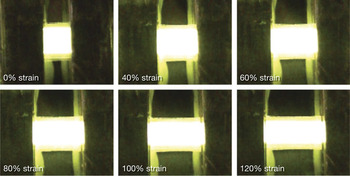Stretchable electronics and displays represent a rapidly expanding technology. While difficult to fabricate due to the challenge of combining elastic components with rigid and brittle inorganic light-emitting diodes and organic light-emitting diodes (OLEDs), these devices offer remarkable advances in the development of expandable and foldable screens, wearable electronics, and biocompatible light sources for in vivo or epidermal medical devices.
In the October issue of Nature Photonics (DOI: 10.1038/nphoton.2013.242; p. 817), J. Liang and co-workers from the University of California–Los Angeles report the fabrication of an elastomeric polymer light-emitting device (EPLED) comprised of an electroluminescent polymer layer sandwiched between a pair of transparent composite electrodes. The group of scientists, led by Qibing Pei, prepared the rubbery composite electrodes by casting a thin silver nanowire (AgNW) network on the surface of a poly(urethane acrylate) (PUA) matrix. The electroluminescent polymer layer is a blend of commercially available products such as SuperYellow, a yellow light-emitting polymer, ethoxylated trimethylolpropanetriacrylate (ETPTA), poly(ethylene oxide) (PEO), and lithium trifluromethane sulfonate (LiTf). The resulting EPLEDs exhibit high transparency, emit from both surfaces with uniform high efficiency, and are collapsible at room temperature. Light emission continues even when the device is exposed to strains as large as 120%, and they can be stretched repeatedly up to 1000 times at 30% strain.

Device characterization of a stretchable polymer light-emitting electrochemical cell. Reproduced with permission from Nat. Photonics. 7 (2013), DOI: 10.1038/nphoton.2013.242; p. 817. © 2013 Macmillan Publishers Ltd.
In another experiment, the researchers showed that the device can be bent and folded without mechanical or electrical damage and without compromising its light-emitting properties. With these promising results, the researchers anticipate that fully stretchable OLED displays for high-resolution display of information will be achieved in the near future.


